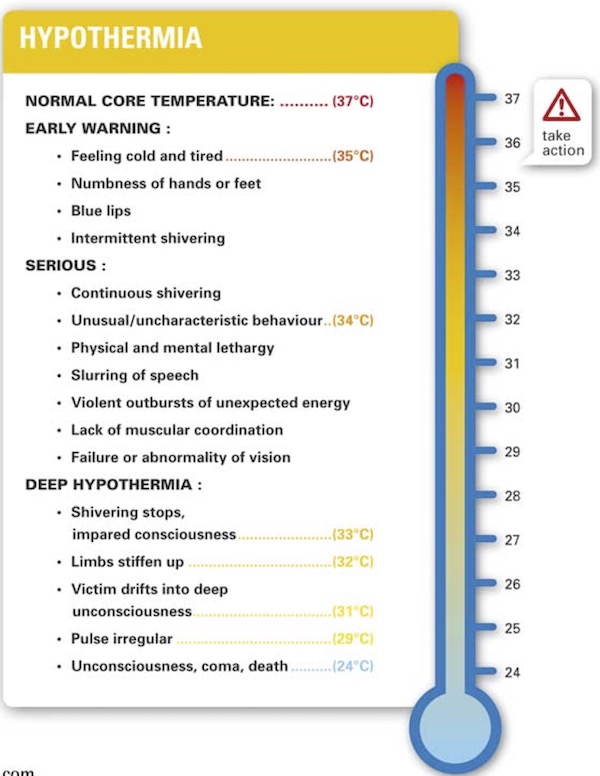5.1 Hypothermia / Hyperthermia
5.1.1 Hypothermia
Hypothermia is a condition brought about by the lowering of the body’s core temperature. It can badly affect judgement and be very dangerous. The diagram below shows typical symptoms against core body temperature.

The best approach is avoid becoming hypothermic:
- Avoid swimming
- Maintain personal fitness
- Eat well before paddling
- Wear suitable clothing
- Look after each other, watch out for early signs
- Be flexible in plannin
- Be aware that if one person is getting cold, the rest of the group probably are as well
It is useful to distinguish types of hypothermia by the speed on onset, although in reality these lie in a spectrum and both can occur together:
Immersion hypothermia occurs quickly following submersion in cold water. If the victim can be re-warmed effectively, they are likely to recover rapidly and can then continue.
Exhaustion hypothermia which sets in over a longer period and will involve depletion of energy, meaning the victim can become unfit to continue.
Early stage hypothermia is treated by:
Preventing further use of energy
Preventing further heat loss - e.g. more clothes, shelter, sleeping bag
Slowly rewarm, ideally with warm moist air. This can be done effectively in a group shelter. In a tent or hut, a pot of boiling water on a stove can help
Encourage victim to eat
Serious hypothermia is treated in the same way, but will require hospital treatment and potentially a very difficult evacuation (stretcher).
Especially for more serious cases, attempts to rewarm the skin by hot objects or rubbing can be counterproductive as they may cause blood to flow from the core to peripheral vessels.
For those wanting to learn more, the classic (20 minute) video ‘Cold, Wet and Alive’ is worth watching. Although long and somewhat dated, it’s a realistic portrait of the downward spiral that can set in when things start going wrong in chilly conditions.
5.1.2 Hyperthermia
Hyperthermia describes a range of medical conditions caused by hot weather. The table provides a brief summary. Like hypothermia, avoidance is the best tactic - drink lots, dress for the conditions, wear suncream, sun hat and sunglassees and use seawater to keep cool if it’s really hot.
| Condition | Symptoms | Treatment |
|---|---|---|
| Dehydration | Dry mouth, headache, dizziness, dark urine, cramp | Drink plenty of fluids |
| Sunburn | Red skin, blistering | Cover skin, cool skin by dabbing with water, drink fluids |
| Heat exhaustion | Headaches, dizziness, confusion, nausea, sweating with clammy skin, cramps, rapid weak pulse and breathing | Cool casualty down, give plenty to drink, ideally with oral re-hydration salts. Monitor carefully for signs of heatstroke. |
| Heatstroke | Can follow heat exhaustion, when the body’s thermostat fails and sweating ceases. Symptoms as heat exhaustion, but skin is now hot, flushed and dry, pulse is full and bounding and core temperature rises. | Cool casualty with wet clothes or sheets. Get medical help (e.g calling 999). Monitor carefully. |